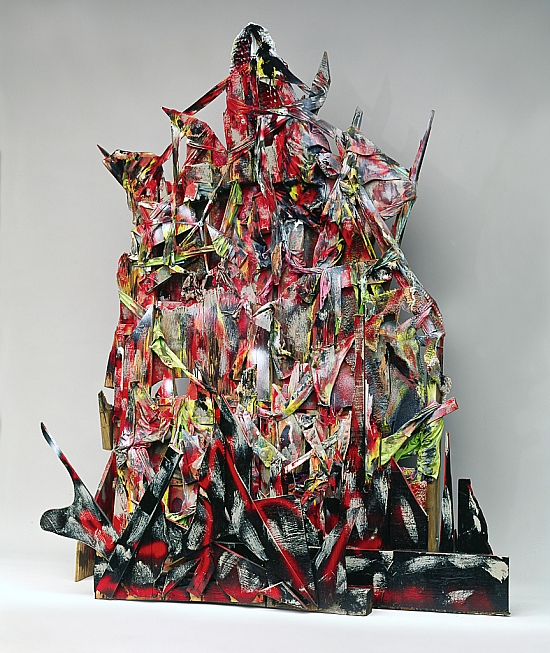The World Trade Center attacks were simultaneously an excruciating personal experience affecting Dial along with everyone else in the country and a distant event taking place up close on television. All the world saw the World Trade Center attacks on TV. For everyone in America it was happening in real time in their bedrooms and living rooms. Dial began by responding in the way he had to the assaults on civil rights marchers, with ferocity and intimacy. While the towers were still burning, he began The Morning of the End of the World.
The piece consists of three stepped upright planar forms, roughly constructed out of boards. The largest is a wooden hulk that suggests a jagged mountain as well as a 110-story column of shattering concrete and melting steel. To Dial, mountains have a number of contradictory meanings, some of them taken from Martin Luther King Jr., for whom a mountain was Moses’s site of inspiration and prophecy. But for King, a mountain was also an emblem of the injustices and suffering that the white world inflicted on the black: “I have a dream that one day every valley shall be exalted, every hill and mountain shall be made low, the rough places will be made plain, and the crooked places will be made straight, and the glory of the Lord shall be revealed, and all flesh shall see it together.”
To Dial a mountain also signifies power, particularly the power of “The United States of America,” as he says, enunciating the whole title every time he says it. So his rupturing mountain evokes destruction in high places, particularly since the apex of commerce is falling upon the two lower layers of jagged peaks, crushing the downtown New York skyline already dwarfed by the mammoth towers, annihilating the workers below, in their fast-food shops and subway cars. Layers of paint are slathered, gouged, wiped, and thrust upon cloth that drapes and sags, as though melting over the wooden boards. Its colors are the colors of steel at a temperature hot enough to be manipulated in a processing plant: crimson, chartreuse, white, gray, black and orange and violet. Dial understands hell from within as well as without. —Amei Wallach
